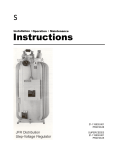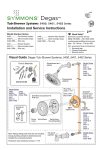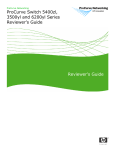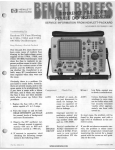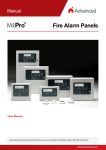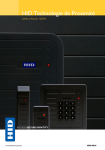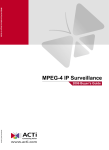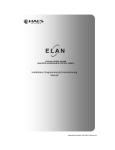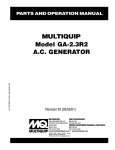Download Siemens PR4018-05 Instruction manual
Transcript
Installation / Operation / Maintenance Instructions 21-115532-001 PR4018-06 JFR Distribution Step Voltage Regulator SUPERCEDES 21-115532-001 PR4018-05 October 08 TABLE OF CONTENTS Page INTRODUCTION Inspection for Damage in Shipment ................... 2 Storage Prior To Installation ............................. 2 Physical Considerations ................................... 3 Line Terminals and Connections ....................... 3 Electrical Considerations .................................. 3 Installation Diagrams........................................ 4 Protective Measures ........................................ 5 Control Connections ........................................ 5 Connection Diagrams Straight Design ................................................ 6 Inverted Design................................................ 7 Series Transformers Design ............................. 8 Placing the Regulator in Service Before Connecting ........................................... 9 Connecting ...................................................... 9 Switching On-Line ............................................ 9 Checking Regulator Operation .......................... 9 Removing the Regulator From Service .............10 Maintenance General Instructions ........................................11 Operational Checks .........................................11 Periodic Inspection..........................................12 Page Special Features Polarized Disconnect Switch and Hinged Control Panel ......................................... 13 Remote Mounting of Control Equipment ..................... 13 Vari-AMP TM Position Indicator................................... 13 Operation at Less Than Rated Voltage......................... 14 Forced Air Cooling ................................................... 15 Subbase Assembly .................................................. 15 Parts List Major Components ................................................... 16 Position Indicator ................................................... 17 Type TLG Dial Switch ............................................. 18 Type TLG Quick Break Mechanism ........................... 19 Type TLF Dial Switch ............................................... 20 Type TLF Quick Break Mechanism............................ 21 Bypass Arresters ..................................................... 22 Bushings................................................................. 23 For Emergency Service Call: 1-877-742-3309 Siemens Energy, Inc. THESE INSTRUCTIONS DO NOT PURPORT TO COVER ALL DETAILS OR VARIATIONS IN EQUIPMENT, NOR TO PROVIDE FOR EVERY POSSIBLE CONTINGENCY TO BE MET IN CONNECTION WITH INSTALLATION, OPERATION OR MAlNTENANCE. SHOULD FURTHER INFORMATION BE DESIRED OR PROBLEMS ARISE WHICH ARE NOT COVERED SUFICIENTLY FOR THE PURCHASER’S PURPOSES, THE MATTER SHOULD BE REFERRED TO YOUR SIEMENS ENERGY, INC. REPRESENTATIVE. THE CONTENTS OF THIS INSTRUCTION MANUAL SHALL NOT BECOME PART OF OR MODIFY ANY PRIOR OR EXISTING AGREEMENT, COMMITMENT OR RELATIONSHIP. THE SALES CONTRACT CONTAINS THE ENTIRE OBLIGATION OF SIEMENS ENERGY, INC. THE WARRANTY CONTAINED IN THE CONTRACT BETWEEN THE PARTIES IS THE SOLE WARRANTY OF SIEMENS ENERGY, INC. ANY STATEMENTS CONTAINED HEREIN DO NOT CREATE NEW WARRANTIES OR MODIFY THE EXISTING WARRANTY. INTRODUCTION Page 1 Type JFR single-phase step-voltage regulators are designed to give dependable service and to make installation, operation and maintenance as simple as possible. Technology advances, especially in the realm of the control apparatus, make it efficient to provide a separate instruction manual for the Accu/StatTM control provided with this JFR Regulator. For specific control information, refer to the Accu/StatTM control manual included with the regulator. QUALIFIED PERSON FOR THE PURPOSE OF THIS MANUAL AND PRODUCT LABELS, A QUALIFIED PERSON IS ONE WHO IS FAMILIAR WITH THE INSTALLATION, CONSTRUCTION AND OPERATION OF THE EQUIPMENT, AND THE HAZARDS INVOLVED. IN ADDITION, HE HAS THE FOLLOWING QUALIFICATIONS: (a) Is trained and authorized to de-energize, clear, ground and tag circuits and equipment in accordance with established safety practices. (b) Is trained in the proper care and use of protective equipment such as rubber gloves, hard hat, safety glasses or face shields, flash clothing, etc., in accordance with established safety practices. (c) Is trained in rendering first aid. Hazardous Voltage. Death or serious injury from electrical shock, burns will result from misuse. To prevent: Do not service or touch until you have de-energized high voltage, grounded all terminals and turned off control voltage. Grounding terminals with line to ground capacitors may produce a small arc. Only qualified personnel should work on or around this equipment after becoming thoroughly familiar with all warnings, safety notices, instructions and maintenance procedures contained herein. The successful and safe operation of this equipment is dependent upon proper handling, installation, operation and maintenance. Distinctive signal words (DANGER, WARNING, CAUTION) are used in this instruction book to indicate degrees of hazard that may be encountered by the user. For the purpose of this manual and product labels these signal words are defined below. DANGER Indicates an imminently hazardous situation which, if not avoided, will result in death or serious injury WARNING Indicates a potentially hazardous situation, which, if not avoided, could result in death or serious injury. CAUTION Indicates a potentially hazardous situation which, if not avoided, may result in minor or moderate injury. INTRODUCTION Page 2 INSPECTION FOR DAMAGE IN SHIPMENT STORAGE PRIOR TO INSTALLATION Check each item with the shipping manifest immediately upon receipt of the regulator. Make a thorough visual inspection of the regulator. Check for evidence of damage attributable to mishandling in shipment. Should any shortage or damage be found, notify the local agent of the carrier making the delivery and make appropriate notation on the freight bill. Any damage or shortage that is not noted on the freight bill becomes the recipients responsibility. A claim should be made immediately with the carrier. Please also notify your Siemens representative as soon as possible. Assure that the control compartment enclosure is tightly closed, and regulator tank is sealed. INTRODUCTION Page 3 PHYSICAL CONSIDERATIONS • Handling. Type JFR regulators are designed to be lifted either by a forklift at the base or by use of lifting hooks on the side of each tank. Each JFR regulator is provided with either 2 or 4 lifting hooks on the side of each tank. The number of hooks has been established to provide a margin of safety. Use all supplied lifting hooks when lifting. WARNING Type JFR voltage regulators are routinely equipped with line bushing terminals per the following criteria. Nameplate Line Current Rating Conductor Size Range or Threaded Stud Size 50A to 300A 301A to 668A 669A to 1200A 1201 A to 2000A #2 to 477 MCM #2 to 800 MCM 1.125- 12 UNF-2A 1.500- 12 UNF-2A Improper use of lifting provisions can cause death, serious injury, or equipment damage. Clamp type terminals for use through 668 ampere are capable of accepting an aluminum or copper conductor. To prevent: Tank grounding provision consists of a 0.5-13NC tapped hole in a steel pad for regulators rated to 300 amperes. Above 300 ampere ratings, a stainless steel pad with two 0.5-13NC tapped holes is provided. Do not use cover lifting eyes to lift complete unit. Cover lifting eyes are for untanking only. • LINE TERMINALS AND CONNECTIONS Location. Type JFR regulators are designed for outdoor installation. Any regulator may be platform or pedestal mounted. Regulators provided with hanger brackets are suitable for pole mounting. When the regulator is to be installed in a substation on a pedestal it is recommended that a minimum elevation to the live connection be established, as required by applicable codes. ELECTRICAL CONSIDERATIONS Type JFR regulators are commonly installed using any of four electrical configurations. • One regulator in single-phase application. (Figure 4A) • Three regulators in wye on a grounded-neutral threephase system. (Figure 4D) • Two regulators in open delta on a three-phase ungrounded system. (Figure 4B) • Three regulators in closed delta on a three-phase ungrounded system. (Figure 4C) Hazardous voltage present at the line terminals of the bushings on the cover of the regulator. Will cause serious injury or death. To prevent: De-energize the regulator before servicing. Elevation. When the regulator will be used at an elevation above 1000 meters (3300 feet) the kVA rating must be derated per ANSI C57.15 to assure operating temperature limits are not exceeded. Each of the four alternatives, when complete with switching provisions, will take the electrical configuration as shown on the next page. The descriptions 'S', 'L', and 'SL' are embossed into the cover for user convenience at time of installation. INTRODUCTION Page 4 INSTALLATION DIAGRAMS Open Delta Single Phase Connection of one single phase JFR regulator on single phase line. Closed Delta 4C) Connection of three JFR regulators in closed delta on three phase, ungrounded system. Connection of two single phase JFR regulators in open delta on a three phase, ungrounded line. Wye Connected Connection of three single phase JFR regulators in wye on a three phase, grounded neutral system. INTRODUCTION Page 5 PROTECTIVE MEASURES Bypass Arrester. All JFR regulators are equipped with a properly sized arrester, connected externally between the 'S' and 'L' line terminals. The arrester is provided to protect the series winding of the regulator from line surges. By itself, the bypass arrester does not provide lightning protection for the regulator. Lightning Protection. The number of lightning arresters used will be a discretionary decision on the part of the user, considering such factors as isokeraunic level and degree of risk of damage to be accepted. The minimum recommended lightning protection consists of a properly sized arrester between the 'S' or 'L' bushing and ground on a single phase or a wye connected system. A delta connection system requires the use of two arresters to accomplish minimum protection levels. Additional protection can be obtained with the use of arresters at both the 'S' and 'L' terminals in single phase or wye systems and on all three terminals on a delta system. Figure 5A For best results, install lightning arresters on the mounting lugs adjacent to the bushings near the top of the tank. The lugs are 0.5 - 13NC located on 2.5 inch centers. Ground the arrester(s) and the regulator tank solidly to the same ground connection. Be careful to keep the ground lead connections as short as possible. For this purpose, it is necessary to use the nameplate drawing and control diagram found in the control enclosure. 1. Refer to the Nameplate. The P2 column indicates the correct connection for lead P2 based on the system voltage. Using the applicable control diagram, the terminal designation of the nameplate can be cross referenced to the proper terminal on the 19-pin terminal block. 2. Depending on the regulator, there may be a second nameplate column indicating that lead U2 should also be connected. If so, the U2 column indicates the correct connection for lead U2 based on the system voltage Using the applicable control diagram, the “U” terminal designation of the nameplate can be cross referenced to the proper terminal on the 19-pin terminal block. 3. For regulator equipped with fans for forced-air cooling, another set of connections will be shown. Thru Fault. Type JFR regulators are rated under condition of thru-faults per ANSI C57.15. The user is advised to provide for additional source impedance, bus sectionalizing or other means of limiting the available thru-fault current if these criteria are exceeded at the installation. CONTROL CONNECTIONS Many regulators can be used at several different nominal system voltages. It is therefore necessary to assure that the regulator is properly connected at the 19 pin upper terminal block for the system voltage on which the particular regulator will be used. NOTE Matters specifically relating to the Accu/StatTM control used in conjunction with the regulator are not included in this manual. Refer to the appropriate control instruction manual. CONNECTION DIAGRAMS Page 6 STRAIGHT DESIGN (ANSI TYPE A) Wiring diagram of a typical Type “A” regulator showing both internal and external connections without fan power. SOURCE S L LOAD SL Schematic diagram of a typical Type “A” JFR regulator with fan power circuit U3-U5. Typical arrangement of windings and connections of Type “A” JFR regulators. Note: Other typical motor supply configurations below. Note: Straight design units may or may not be equiped with a balance winding. Refer to regulator nameplate. CONNECTION DIAGRAMS Page 7 INVERTED DESIGN (ANSI TYPE B) S L SL Wiring diagram of a typical Type “B” regulator showing both internal and external connections. SOURCE S L LOAD SL Typical arrangement of windings and connections of Type “B” JFR regulators. Schematic diagram of a typical Type “B” JFR regulator utilizing single potential source for motor and control circuit. Note: Inverted design units may or may not be equiped with a balance winding. Refer to regulator nameplate. CONNECTION DIAGRAMS Page 8 SERIES TRANSFORMER DESIGN S L SL Wiring diagram of a typical regulator with series transformer showing both internal and external connections. SOURCE S L LOAD SL Schematic diagram of a typical regulator with series transformer with fan power U3-U5. Typical arrangement of windings and connections of Series JFR regulators, without fan power. *Note: Exciting Winding may not be fully tapped. Refer to regulator nameplate. Note: Series Transformer design units may or may not be equiped with a balance winding. Refer to regulator nameplate. PLACING THE REGULATOR IN SERVICE Page 9 The following checks will be useful in assuring the regulator is ready for use. The list cannot be all inclusive; careful attention on the part of a qualified operator remains imperative. Improper By-Pass operation will result in explosion and fire hazard. Will cause serious injury, death or equipment damage. BEFORE CONNECTING • Check oil level at oil sight window. If low, add sufficient oil (ASTM D-3487 Type II) to bring to desired level. • Check oil dielectric strength per ASTM D 877. If found below 25kV, oil should be changed or reconditioned. Reference ANSI C57.106-2002. Note: Oil tests are not required for new equipment. • Perform insulation power factor test per ANSI C57.15. Maximum value is 2.0%. • Verify from the nameplate that the unit is connected for the proper output voltage, motor voltage and control panel voltage. • Assure that the regulator is on the neutral tap position. This should be accomplished by observing the position indicator pointer and by powering the control from a 120V external source and observing the NeutraliteTM to be illuminated. To Prevent: Do NOT install OR remove from service unless Tap Changer is in neutral position AND Control Panel is properly disabled to prevent tap changes while in By-Pass configuration. Read Operators Manual before attempting to ByPass this Regulator. Follow instructions to place into service: 1. 2. 3. 4. 5. 6. 7. 8. 9. 10. Place the Auto/Manual switch in the By-Pass position Place the Raise/Lower switch in "Off" Make certain regulator is in neutral (N) position Turn voltage power source switch to "Off" Remove power fuse Close, sequentially, the source and load switches Open the bypass switch Visually observe that bypass circuit has opened Replace power fuse Place voltage power source switch to "Normal." BEFORE CONNECTING CHECKING REGULATOR OPERATION • Identify 'S', 'L' and 'SL' bushings on the cover. Make electrical connections per the appropriate installation diagrams, page 4, first connecting 'SL' bushing. • Set Vari-Amp See Page 11. • Set Accu/StatTM Control as desired. See Accu/StatTM instruction manual. TM limits on position indicator, if necessary. 1. Refer to applicable Accu/StatTM Control instruction manual.)Turn the Tap Control switch to MANUAL. 2. Run the tapchanger in the lower direction, at least until the control is observed to go out of band "LOW". 3. Turn the Tap Control switch to AUTO. After a time delay, the regulator will return to an "IN" band condition. 4. Turn the Tap Control switch to MANUAL. SWITCHING “ON-LINE” • Improper by-pass operation will result in explosion and fire hazard. Will cause serious injury, death or equipment damage. • Do NOT place into service unless tap-changer is in neutral position AND control panel is properly disabled. 5. Run the tapchanger in the raise direction, at least until the control is observed to go out of band "HIGH". 6. Turn the Tap Control switch to AUTO. After a time delay, the regulator will return to an "IN" band condition. REMOVING THE REGULATOR FROM SERVICE Page 10 SWITCHING “OFF LINE” • Improper by-pass operation will result in explosion and fire hazard. Will cause serious injury, death or equipment damage. • Do NOT remove from service unless tap-changer is in neutral position AND control panel is properly disabled. • If the regulator being removed is in a closed delta bank, it is necessary to bypass and isolate all regulators in the bank. Improper By-Pass operation will result in explosion and fire hazard. Will cause serious injury, death or equipment damage. To Prevent: Do NOT install OR remove from service unless Tap Changer is in neutral position AND Control Panel is properly disabled to prevent tap changes while in By-Pass configuration. Read Operators Manual before attempting to By-Pass this Regulator. Follow instructions to remove from service: 1. 2. 3. 4. 5. 6. 7. 8. 9. Place the Auto/Manual switch in the By-Pass position Place the Raise/Lower switch in "Off" Make certain regulator is in neutral (N) position. If independent checks of the position indicator and NeutraliteTM indicator do not confirm the neutral position, bypassing must not be attempted. In such event, deenergize the system to remove the regulator from service Turn voltage power source switch to "Off" Remove power fuse After assuring the voltage regulator is on neutral, close the bypass switch Open sequentially, the load and source switches (a) For a single phase or grounded wye connection, make sure that the high voltage disconnect switches are opened (b) For a closed delta connection, be sure all regulators in the bank are bypassed and isolated Exercise appropriate care in the removal of the regulator. High voltage will still be present at the bypass switch and the source and load switch terminals. Remove the ground connection last. MAINTENANCE Page 11 GENERAL INSTRUCTIONS OPERATIONAL CHECKS This manual does not represent an exhaustive survey of maintenance steps necessary to ensure safe operation of the regulator. Particular applications may require further procedures. Should further information be desired or should particular problems arise which are not covered sufficiently for the purchaser’s purposes, the matter should be referred to the local Siemens sales representative. Basic regulator operation can be checked while the regulator remains in service. The output voltage can be monitored from the control panel display under the <METER> menu on the “Vld” screen. WARNING Failure to properly maintain the regulator can result in serious injury, death, or equipment damage. The instructions contained herein should be carefully reviewed, understood and followed. • Check the calibration by following the steps in the Basic Troubleshooting section of the Accu/Stat control panel instruction manual. • Run the tapchanger several steps in one direction in the manual mode until the output voltage is outside of the bandwidth. Return the control to automatic mode. After the predetermined time delay, the tapchanger motor will be observed to return the output voltage in-band. Repeat this operation, running the tapchanger in the opposite direction. TM To prevent: The following maintenance procedures should be performed regularly: 1. Operational checks. • Check the Vari-Amp limit switches by attempting to run the tapchanger beyond the position to which the switches are set. The limit switches should function to open the circuit. Note: If the limit switch is set at the maximum 10% range and fails to function, the tapchanger will stall against a mechanical stop. The motor is designed to stall continuously without damage. 2. Periodic inspection. CAUTION Operation of the regulator at extreme tap positions could produce line voltages outside of operating limits that could result in property damage. Hazardous voltages. Will cause serious injury, death, or equipment damage. To prevent: To prevent: Operate the regulator only to judiciously determined voltage extremes. Always de-energize and ground the equipment before maintenance requiring access to high voltage parts. WARNING WARNING The use of unauthorized parts in the repair of the equipment, tampering by unqualified personnel, or faulty repair and adjustments can result in dangerous conditions which can cause serious injury, death, or equipment damage. To prevent: Follow all safety instructions contained herein, and contact your local Siemens sales representative for replacement parts. Regulator may have High Internal Pressure. Can cause serious injury, death, or equipment damage. To prevent: Use pressure relief valve to vent regulator before untanking. MAINTENANCE Page 12 PERIODIC INSPECTION A sample of oil from the regulator should be subjected to dielectric breakdown test, per ASTM D-877. If found below 25kV, the oil should be changed or reconditioned. Refer to ANSI C57.106-2002. Other tests, especially Neutralization Number, Interfacial Tension and Power Factor are also useful and may be preferred by particular users. The oxidation inhibitor in the oil will be depleted over a period of a few years and should be replaced. The inhibitor is 2, 6ditertiary-butyl-para-cresol (DBPC) at a concentration level of 0.2 to 0.3%. When inspecting, check to be certain all hardware and connections are tight. The principal point of the internal inspection will be the condition of the arcing contacts on the tapchanger. Since numerous factors influence the rate of contact tip wear, no one criteria can be stated to recommend when a contact should be changed. The following figure shows the possible condition of contact wear after a period of operation. If the contact surface is less than 1/8 inch wide, the contact should be replaced. (See the Figure below) Contacts, both movable and stationary, show normal burning and wear once placed in service. If for any reason A1 dimensions exceed 4/5 of A, the stationary contact should be replaced. (See the Figure below) The time interval between internal inspections will depend upon frequency of tapchanger operation and the load on the regulator. Regulators subjected to numerous overloads and a high load factor may require more frequent inspections than those carrying normal loads. While internal inspection is not a necessity, preventive maintenance inspections will help assure the continuity of service. To untank a JFR regulator, proceed as folllows: 1. Remove the regulator from service as described on Page10. A A1 Hazardous voltages. Will cause serious injury, death, or equipment damage. To prevent: Always de-energize and ground the equipment before maintenance requiring access to high voltage parts. • UPPER FILTER PRESS SEALING If cover top cap is removed, make certain the cap is properly sealed when replaced on cover. Siemens recommends applying pipe sealant (Loctite PST or equivalent) around the threads of the adapter. Furthermore, it is recommended that the seal be tested by applying 5 psig pressure through the pressure relief valve fitting for 5 minutes, with no loss in pressure. Failure to assure seal may allow moisture to be pulled into the unit during a cool-down cycle. 2. Place the regulator in a position where energized overhead lines will not interfere. • FAN MAINTENANCE 3. Operate pressure relief valve to vent regulator before untanking Cooling fans (if equipped), require minimum attention. Fans with plain sleeve bearings or Oil-Lite sleeve bearings should be oiled at least once a year with SAE 10-W engine oil which does not thicken in cold weather. Oil must be added to sleeve bearings before starting motor for the first time after installation. 4. Remove the mounting bolts holding the control box onto the main tank. 5. Remove all cover bolts. 6. The regulator can now be pulled from the main tank by the cover lifting eyes. Fans equipped with ball bearing motors are packed with grease before shipment and should be greased at least once a year with a soda-soap, ball-bearing grease of medium consistency furnished by a reliable supplier. SPECIAL FEATURES POLARIZED DISCONNECT SWITCH (JACK PLUG) AND HINGED CONTROL PANEL The Accu/StatTM control panel is hinged and may be removed completely from the regulator control box by removing the wing nuts on the polarized jack plug and pulling the jack from its fixed position. This will automatically de-energize the control. It is not necessary to bypass or de-energize the regulator to remove the control. A spring-loaded shorting bar in the plug automatically short circuits the current transformer secondary when the jack is removed. REMOTE MOUNTING OF CONTROL EQUIPMENT The Accu/StatTM control may be remotely mounted. Remote cable is available in standard lengths of 18, 25 and 30 feet incorporating oil and moisture resistant, color-coded conductors. Page 13 VARI-AMPTM POSITION INDICATOR The Vari-AmpT M feature provides a method of operating the regulator at increased load by decreasing the range of operation. It provides operator flexibility by allowing the range of regulation to be adjusted in 1¼ percent increments. The various regulation ranges together with the corresponding current capacities for standard regulators are listed on the next page. All that is necessary to adjust the range of regulation anywhere from ±5 percent to ±10 percent is to turn the adjusting knobs until the proper range of regulation is shown on the side of the position indicator. The upper and lower limits need not be the same. It is not necessary to remove the regulator from service to make this adjustment. The switches are, however, in the motor power circuit so the motor should not be running while the switches are being set. SPECIAL FEATURES Page 14 OPERATION AT LESS THAN RATED VOLTAGE JFR regulators may be operated at less than the voltage for which they were designed. All system voltages for which control system taps have been provided are shown on the nameplate. When this is to be accomplished it may be necessary to reconnect particular leads at the upper 19-pin terminal block as illustrated on page 5. When operating the regulator at reduced voltage it must be noted that the regulator carries a maximum current rating which rules regardless of the voltage (see table at right). It may therefore be necessary to operate the regulator at less than its nameplate kVA rating. Units with catalog number starting with: 10 are self cooled 11 are forced-air cooled Regulators can be modified at factory for 50 Hz operation with appropriate de-rating of voltage. *Capable of carrying current corresponding to rated kVA when operated at 7200/12470 volts ground wye. VARI-AMP ±10% TM RANGE AND CURRENT RATINGS AVAILABLE ±8 3/4% ±7 1/2% ±6 1/4% ±5% 10-02.5-050.0 10-02.5-075.0 10-02.5-100.0 10-02.5-167.0 10-02.5-250.0 10-02.5-333.0 11-02.5-416.3 200 300 400 668 1000 1332 1665 220 330 440 668 1000 1332 1665 240 360 480 668 1000 1332 1665 270 405 540 668 1000 1332 1665 320 480 640 668 1000 1332 1665 10-05.0-050.0 10-05.0-100.0 10-05.0-167.0 10-05.0-250.0 10-05.0-333.0 11-05.0-416.3 100 200 334 500 668 835 110 220 367 550 668 835 120 240 401 600 668 835 135 270 451 668 668 835 160 320 534 668 668 835 10-07.6-038.1 10-07.6-057.2 10-07.6-076.2 10-07.6-114.3 10-07.6-167.0 10-07.6-250.0* 10-07.6-333.0* 10-07.6-416.3* 10-07.6-500.0 10-07.6-667.0 11-07.6-889.0 50 75 100 150 219 328/347 437/463 546/578 656 875 1167 55 83 110 165 241 361/381 481/509 601/636 668 875 1167 60 90 120 180 263 394/416 524/556 656/668 668 875 1167 68 102 135 203 296 443/468 590/625 668/668 668 875 1167 80 120 160 240 351 525/555 668/668 668/668 668 875 1167 10-13.8-069.0 10-13.8-138.0 10-13.8-207.0 10-13.8-276.0 50 100 150 200 55 110 165 220 60 120 180 240 68 135 203 270 80 160 240 320 10-14.4-072.0 10-14.4-144.0 10-14.4-288.0 10-14.4-333.0 10-14.4-432.0 10-14.4-576.0 11-14.4-720.0 10-14.4-833.0 50 100 200 231 300 400 500 578 55 110 220 254 330 440 550 636 60 120 240 277 360 480 600 668 68 135 270 312 405 540 668 668 80 160 320 370 480 640 668 668 10-19.9-100.0 10-19.9-200.0 10-19.9-333.0 10-19.9-400.0 10-19.9-667.0 11-19.9-833.0 50 100 167 200 335 418 55 110 184 220 368 459 60 120 201 240 402 502 68 135 226 270 452 565 80 160 268 320 536 668 SPECIAL FEATURES Page 15 FORCED AIR COOLING SUBBASE ASSEMBLY Certain regulators may be equipped for forced-air cooling and include fans mounted on the radiators. The fans are usually automatically controlled by means of the change in oil temperature (see Connection Diagram). The thermometer located in the top transformer oil contains two identical switches which control fan operation when fan control switch is in “Auto” position. Subbase assemblies are available in 4-inch high increments from 21 through 49 inches for most JFR regulators. The proper height is selected by picking the elevation that will provide required clearance from foundation to the live part of the regulator bushing. The switches are normally set to start the fans at 65°C and to stop them at 55°C top oil temperature, but may be adjusted plus or minus 5°C. A thermal overload relay is mounted on each fan motor. Any fan that develops trouble will be automatically disconnected from the line without affecting the other fans of the system. One fan can be removed from the radiators without affecting the operation of the others. When fans are out of service, care must be exercised to prevent overloading the regulator. PARTS LIST Page 16 MAJOR COMPONENTS PARTS LIST Instructions For Ordering Part When ordering parts give the quantity of parts required, the regulator serial number, parts list item number, complete description, and method of shipping. State whether for emergency repair, maintenance, spare part, etc. All shipments will be made F.O.B Factory Item 01-11 Description 5050A 5079 5081 5083 5084 5085 5087 5088 5092 5094B 5095 5246 5287 17 80 81A 90A Control Compartment Gasket Position Indicator Main Cover Gasket Pressure Relief Valve Terminal Box Gasket Nameplate Sampling Device Grounding Lug Terminal (not shown) Terminal Block Clamp Terminal Block Studs Terminal Block Gasket Motor Capacitor TLG Motor Capacitor TLF Drain Valve Oil Sight Glass Oil Sight Gauge Gasket Bolts - Stainless Steel PARTS LIST Page 17 TYPE TLG DIAL SWITCH Item 01-11 5320 5317A 5321 5322 5323 5324 5325 5326 5327 Description Panel Reversing Main Shaft Main Stationary Contacts Reversing Stationary Contact R Reversing Stationary Contact L Neutral Stationary Contact Collector Ring Collector Hub Reversing Switch Arm Item 01-11 5328A 5328B 5329 5330 5331 5332 5333 5334 5336 Description Reversing Switch Finger Assembly Reversing Switch Hub Finger Assembly Drive Arm Hub Finger Support Ring Finger Support Main Moving Finger Assembly Hub Finger Assembly Ring Finger Assembly Phenolic Drive Pin PARTS LIST Page 18 TYPE TLG QUICK BREAK MECHANISM Item 01-11 Description Item 01-11 5201G 5202 5207 5212 5213 5214 *5216A *5216B *5216C 5217 5229 5231 5233A 5234 5237 Mounting Frame Assembly Motor Drive Spring Assembly Latch Assembly Latch Spring (not shown) Latch Pin (not shown) Reversing Switch Drive Arm - Phenolic Reversing Switch Drive Arm - Phenolic Rev. Switch Drive Arm – Glass Phenolic Interlock Disk And Drive Assembly Main Shaft w/Sleeve Bearing Motor Mounting Bracket Operation Counter Switch Assembly Roller Chain Position Indicator Reversing Switch Shaft 5238 5240 5241 5242 5243A 5244 5245A 5246 5247 5248 5250 5273 5600 Reversing Switch Assembly Spring Spring Tube Position Indicator Drive Mechanism Neutral Switch Index Plate Motor Sprocket Capacitor for Motor Sprocket Assembly Main Drive Chain Assembly Drive Pin Phenolic Spacer Flexible Shaft 5600A Flexible Shaft O-Ring Description PARTS LIST Page 19 TYPE TLF DIAL SWITCH FIGURE 20A Item 01-11 5351 5352 5353 5354 5355 5356 5357 5358A 5359 5360A Description Panel Stationary Contact Neutral Stationary Contact Stationary Contact - LH Stationary Contact - RH Collector Ring Shaft Assembly Main Finger Assembly (each) Contact Finger Assembly Collector Ring Contact Finger Assembly Collector Hub Item 01-11 Description 5363 5364 5365 5366 5367 5368 5369 5370 5373 Drive Plate Contact Finger Assembly - Rev. Switch Contact Support Assembly Reversing Drive Pin Reversing Shaft Spacer Contact Finger Support Contact Finger Support Reversing Switch Stop PARTS LIST Page 20 TYPE TLF QUICK BREAK MECHANISM Figure 21A Item 01-11 5233A 5243B 5251 5252 5256 5257 5259 5260 5262 5263 5264 5265 Description Counter Switch Assembly Neutral Switch Mounting Frame Motor Drive Spring Tube Drive Spring Spacer Notched Index Plate Latch Latch Spring Latch Pin Reversing Switch Drive Arm Item 01-11 Description 5266 5267 5275 5276 5278 5285 5286 5287 5288 5289 5290 5291 5600 Interlock Disc and Drive Sprocket Assembly Quick Break Mechanism Shaft Actuating Arm Assembly Spacer A-Frame Drive Chain for Position Indicator Motor Sprocket Motor Capacitor (may be located in control box) Actuating Disc and Sprocket Main Drive Chain Position Indicator Drive Mechanism Reversing Switch Spring Assembly Flexible Shaft 5600A Flexible Shaft O-Ring PARTS LIST Page 21 BYPASS ARRESTERS Item 01-11 Description Volts 5423 5425 Bypass Arrester Assembly 3 kV MOV Mounting Bracket Assembly 2,500, 5,000, 7,620 5423 5425 Bypass Arrester Assembly, 3 kV MOV 12,000-13,800-14,400 5428 5429 Bypass Arrester Assembly, 6 kV MOV Mounting Bracket Assembly Mounting Bracket Assembly 19,920 Include regulator serial number when ordering replacement parts Figure 22B Polymer arresters now used on voltage regulators. Supersedes previous porcelain arresters. Figure 22A PARTS LIST Page 22 BUSHINGS Item 01-11 5400P 5400R 5400S 5401P 5401R 5401S 5410 5419 5411 5418 5426 5430 5427 4034 Description kVA Volts Bushing Assembly for 15 kV 50 5000 38.1 thru 76.2 7620 69 thru 138 13,800 Bushing Assembly for 15 kV 50 2500 100 5000 114.3 thru 167 7620 Bushing Assembly for 15 kV 75 2500 414 13,800 Bushing Porcelain for 15 kV 50 5000 38.1 thru 76.2 7620 69 thru 138 13,800 Bushing Porcelain for 15 kV 50 2500 100 5000 Bushing Porcelain for 15 kV 114.3 thru 167 7620 Clamping Ring for 5400 and R Ratings 75 2500 Clamping Ring for 5400S Rating 414 13800 Cushion Spring Cap Screw Bushing Cap Line Terminal for 5400P Rating Bushing Cap Line Terminal for 5400R and S Ratings Gasket Gasket Figure 23A PARTS LIST Page 23 BUSHINGS z Item 01-11 Description 5400T Bushing Assembly 15 kV 5400U 5400V Bushing Assembly, 15 kV Bushing Assembly, 23 kV 5400W Bushing Assembly 15 kV 5400X 5400Y Bushing Assembly, 23 kV Bushing Assembly, 23 kV 5400YY 5400Z 5400AB 5400AC 5401T Bushing Assembly, 15 kV Bushing Assembly, 23 kV Bushing Assembly, 23 kV Bushing Assembly, 15 kV Bushing Porcelain, 15 kV 5401U 5401V Bushing Porcelain, 15 kV Bushing Porcelain, 23 kV 5401W Bushing Porcelain, 15 kV 5401X 5401Y Bushing Porcelain, 23 kV Bushing Porcelain, 23 kV 5401YY 5401Z 5401AB 5401AC 4025 kVA 100 thru 167 167 250 thru 509 207-276 72 thru 144 100 thru 200 333 thru 416.3 250 thru 416.3 576 thru 833 288 333 thru 400 333 333 thru 432 667 thru 833 667-889 100 thru 167 167 250 thru 509 207-276 72 thru 144 100 thru 200 250 thru 416.3 250 thru 416.3 576 thru 833 288 333 thru 400 333 333 thru 432 667 thru 833 Volts 2500 500 7620 13,800 14,400 19,920 2500 5000 14,400 14,400 19,920 12,000 14,400 19,920 7620 2500 5000 7620 13,800 14,400 19,920 2500 5000 14,400 14,400 19,920 12,000 14,400 19,920 7620 Bushing Porcelain, 15 kV Bushing Porcelain, 23 kV Bushing Porcelain, 23 kV Bushing Porcelain, 15 kV Clamping Ring for 5400T X, Z and AB Ratings Clamping Ring for 5400U 4026 V, W (SL Bushing only), Y and YY Ratings Clamping Ring for 5400W 4028 Rating S and L Bushings only Cushion Spring 4030 4027 Gasket 4032 Gasket 4034 Gasket 4035 *Bushing Cap Line Terminal for 5400T X, YY and AB Ratings *Bushing Cap Line Terminal for 5430 5400U, Y and Z ratings *Bushing Cap Line Terminal 5426 for 5400V Rating Cap Screw 5418 *Units rated 250 kVA and above, 2500 and 5000 volts are not supplied with line terminals s Siemens Energy, Inc. P.O. Box 6289 Jackson, MS 39288-6289 Phone: 601-939-0550 Fax: 601-939-3606 ACCU/STAT, DATA/PAK, NEUTRALITE and VARIAMP are trademarks of Siemens Energy, Inc. PR4018-06 PR4018-05 PR4018-04 October 08 PRINTED IN U.S.A.




























